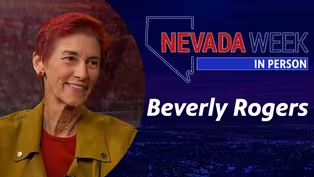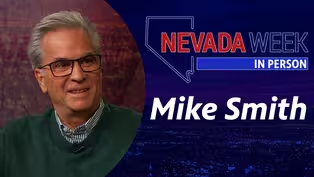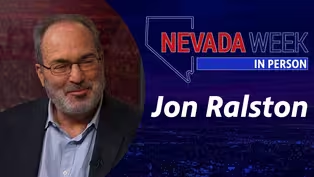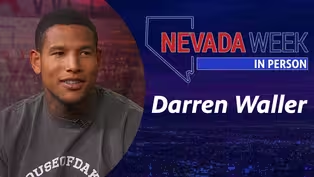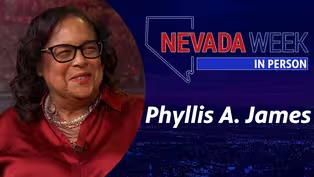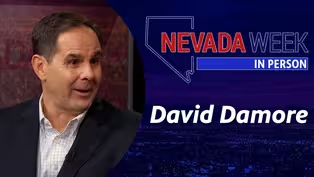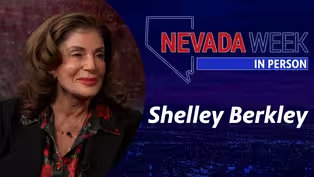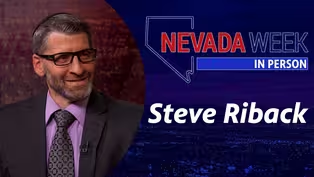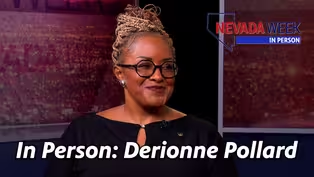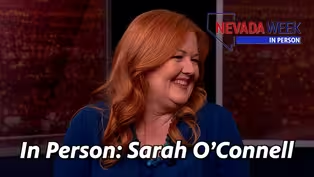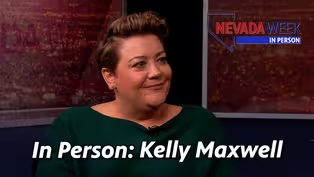
Nevada Week In Person | John Katsilometes
Season 1 Episode 16 | 14mVideo has Closed Captions
One-on-one with Las Vegas Review-Journal columnist John Katsilometes.
A one-on-one interview with Las Vegas Review-Journal entertainment columnist John Katsilometes.
Problems playing video? | Closed Captioning Feedback
Problems playing video? | Closed Captioning Feedback
Nevada Week In Person is a local public television program presented by Vegas PBS

Nevada Week In Person | John Katsilometes
Season 1 Episode 16 | 14mVideo has Closed Captions
A one-on-one interview with Las Vegas Review-Journal entertainment columnist John Katsilometes.
Problems playing video? | Closed Captioning Feedback
How to Watch Nevada Week In Person
Nevada Week In Person is available to stream on pbs.org and the free PBS App, available on iPhone, Apple TV, Android TV, Android smartphones, Amazon Fire TV, Amazon Fire Tablet, Roku, Samsung Smart TV, and Vizio.
Providing Support for PBS.org
Learn Moreabout PBS online sponsorshipMore from This Collection
Nevada Week In Person goes beyond the roundtable discussion of Nevada Week with guests for a more casual conversation about their personal passions, new projects and compelling stories that are overlooked in the flurry of the news cycle.
Nevada Week In Person | Beverly Rogers
Video has Closed Captions
One-on-one interview with Rogers Foundation chair Beverly Rogers. (14m)
Nevada Week In Person | Mike Smith
Video has Closed Captions
One-on-one interview with Las Vegas Sun political cartoonist Mike Smith. (14m)
Nevada Week In Person | Jon Ralston
Video has Closed Captions
One-on-one interview with The Nevada Independent CEO Jon Ralston. (14m)
Nevada Week In Person | Darren Waller
Video has Closed Captions
One-on-one interview with Las Vegas Raider tight end Darren Waller. (14m)
Nevada Week In Person | Phyllis A. James
Video has Closed Captions
One-on-one interview Phyllis A. James. (14m)
Nevada Week In Person | David Damore
Video has Closed Captions
One-on-one interview with Chair of the Department of Political Science at UNLV David Damor (14m)
Nevada Week In Person | Shelley Berkley
Video has Closed Captions
One-on-one interview Senior Vice President for Touro University Shelley Berkley. (14m)
Nevada Week In Person | Liz Ortenburger
Video has Closed Captions
One-on-one interview with SafeNest CEO Liz Ortenburger. (14m)
Nevada Week In Person | Steve Riback
Video has Closed Captions
One-on-one interview with Las Vegas Metro Police Lieutenant Steve Riback. (14m)
Nevada Week In Person | DeRionne Pollard
Video has Closed Captions
One-on-one interview Nevada State College President DeRionne Pollard. (14m)
Nevada Week In Person | Sarah O’Connell
Video has Closed Captions
One-on-one interview with Director of Eat More Art LLC Sarah O’Connell. (14m)
Nevada Week In Person | Kelly Maxwell
Video has Closed Captions
One-on-one interview with Baby’s Bounty Executive Director Kelly Maxwell. (14m)
Providing Support for PBS.org
Learn Moreabout PBS online sponsorshipFrom Cirque shows to A-list residencies and everything in between, John Katsilometes, also known as Johnny Kats, has covered it all.
The longtime entertainment reporter joins me this week for Nevada Week In Person.
♪♪♪ Support for Nevada Week In Person is provided by Senator William H. Hernstadt and additional supporting sponsors.
(Amber Renee Dixon) Entertainment is a major industry in Southern Nevada, and for more than two decades, the person who has covered the entertainers, the big shows, the small lounge acts and the behind-the-scenes is reporter John Katsilometes.
John, welcome to In Person.
-Good to see you.
-So happy to have you in.
I know you have kind of a wacky schedule.
A couple weeks ago when you heard I first got this job, you texted me and when I got the text, it was about 6 a.m. You had sent the text I think about 1 a.m. -Yes, we work completely opposite schedules.
-Yes.
And when I asked you what were you doing at 1 a.m., you said you were riding your bike to the gym.
-I was, yes, that night.
-Is this indicative of what the schedule of an entertainment reporter is like in Las Vegas?
(John Katsilometes) It can be.
I think the point is-- I was actually on Maryland Parkway-- it is indicative of the fact that it's a 24/7 beat, 24/7 city, so I have to be a 24/7 individual.
So fortunately we have 24/7 gymnasiums, and that's what I was doing that night.
But you have to work your life in as you can when you can.
Yes, I do a lot of that kind of thing.
I'm out at all hours.
I'm typically doing normal activity at unusual times.
-Will you rattle off for us some of the A-list celebrities you have come to talk to and know.
-Well, the ones I've known best over the years have been Wayne Newton and Jerry Lewis.
Those two I would say are probably the top of the crop all the way through.
I've known Celine Dion over the years.
Recently Carlos Santana over at House of Blues I've gotten to know, and then down the line.
You know, I've just interviewed everybody who has performed in residency in Las Vegas.
That goes to, you know, Shania Twain, John Fogarty, Ringo Starr.
We're having a conversation with Katy Perry next week.
Luke Bryan is on the current horizon, Gwen Stefani.
-It goes on and on.
-It goes on and on.
I interviewed Brad Paisley last week.
He's in town.
It is pretty much everybody who's-- David Copperfield I've gotten to know pretty well over the recent years.
-From what I understand though, you don't get nervous except if it comes to Steve Martin; why is that?
-Steve Martin, yes, that is true because I grew up a huge Steve Martin fan.
In fact, my family tells me my mannerisms still today are from Steve Martin's appearances on Saturday Night Live when I was a child.
I would watch it when I was a kid.
Hey, you know what I mean?
-Yes, I can see it.
I totally see it.
-And that is inherent.
I used to listen to Let's Get Small, the album, all the time and my verbal pattern, my the cadence, even the way I move.
So I got to the point in my career where I got to interview Steve Martin, and I've interviewed him I think three times total now and I've met him in person.
I got on the phone with him and Martin Short, and I just fell apart.
I mean, I could not maintain my composure in that instance and that very rarely happens.
At least I'm able to-- you know you're talking to a famous person, you know, and I'm a fan of a lot of entertainers, but Steve Martin for some reason I was just like-- I was hyperventilating.
But it got to the point in that conversation, I had known Martin Short.
This helped me because Martin Short I interviewed a few years earlier on the phone, and I've gotten to know him too, and after that first conversation on the phone, they called me back and asked me some questions about Martin Short's stage show.
He was coming into the Mirage, and they asked me what size kilt I would wear, what size tam, if I could catch 150 pounds if it were thrown at me.
And I'm like I'm not sure, probably extra large, yeah.
What is this all about?
They said can you be free to meet Martin at the Mirage Thursday afternoon, tomorrow afternoon?
It was a Wednesday interview.
So I had agreed to be on stage with Martin Short in a scene in his show.
-How cool.
-Yes, and the scene was we come out in kilts and a tam to bagpipe music.
If you saw his show, he comes out and there's a guy with him and he walks out, and then we turn and we face the audience and come out together and then he jumps into my arms and sticks his thumb my mouth and I squeeze him like bagpipes and he bleats out Amazing Grace like he's bagpipes.
I did this three times.
And I had that background when I talked to him, and him and Steve Martin were doing a show together.
So Martin Short interceded and said John is the one I told you about, the one who carried me out at the Mirage.
And Steve Martin says did you find that your career was enhanced or inhibited after that experience?
-Was that your peak point?
(laughter) Yes, and I'm like I don't even know how to answer that or talk through this whole thing.
That's the story of Steve Martin.
I got to meet him in person after the show at the Coliseum too.
-Run through your career for me.
How did you get into journalism?
-Well, I grew up in two places.
I actually grew up in Pocatello, Idaho originally and when I was 13 years old about, my dad and my family moved to Chico, California.
He was a veterinarian in Pocatello, sold his practice, and we moved to Chico to buy orchard land.
The Greek side of my family has farming in it, so I wound up in Chico, California.
I was in high school in Chico, California, and I was an athlete.
I was really athletic, and I loved writing.
I happened to have talent at writing, and I was really into it.
Chico is a small town, so the sports staff was covering my high school teams and I got to know-- I'd known the families of the sports editor and one of the sports editors, his son was one of my best friends growing up.
We all knew each other, and after the summer I graduated from high school, the local paper, the Chico Enterprise Record, had an opening for a sportswriter, like the lowest rung on the sportswriter.
They brought me in and said you're going to be doing this and this and this.
It's the stuff that nobody else wants to do, but you'll be in the door.
Well, a lot of it was typing in results that were just dropped off first of all, so bowling results and, you know-- -Bowling?
-Yes, bowling.
We used to type in bowling leagues.
That was one of the jobs I had.
The first assignment I ever had was the following Friday night, this was during the week, and it was a football game between Hayfork High School and Hamilton City High School, so I covered a football game.
Then the next Sunday I covered a wheelchair tennis tournament, paraplegic tennis tournament, at Chico State University which was actually great.
Looking back on it, what a great first assignment.
I loved it, and I've never done anything quite like that since.
I haven't covered that particular environment since that day.
But I went and covered and talked to all these athletes.
It was really great, and I came back in the office and wrote up the story and I'm like this is really cool.
That was how I started.
I was 18 years old.
-No college though.
You went just straight into it.
Kinda rare.
-It was rare for then and it's unheard of now, but it was really-- and I can only tell you that was just the way it happened for me, you know.
That's how my career was.
I was involved in print journalism, daily journalism from a really early period, and I went for it.
There was always a thought that I would okay, you know, once I get my footing here, I'll be able to go back to school and do this, and that never happened for me.
Simply because I loved what I was doing so much, and Chico State University had a very strong journalism program and they were sending interns over to us.
So here I am 18, 19, 20 years old and training and providing leadership and guidance and direction to young journalists who were probably 24, 25 years old and new grad students, and a lot of them are still in the field.
They're still editors today.
And that was just how it was for me, you know.
It was just how it was.
You know, I did seven years in Chico then I was in Redding, California north of there for another five years.
I had known some folks who I'd worked with in Chico who had gone on to Las Vegas, because Chico's paper and the Las Vegas Review-Journal were owned by the same company, Donrey Media Group, so they were in the same family.
They had an opening for the Rebels, the UNLV Runnin' Rebels beat, the basketball team, and this is the era when Bill Bayno coached the team in 1996.
-So sports is what brought you here, not entertainment.
-Oh, all the way.
I had a 14-year sports career, a 12-year sports career before I ever came to Las Vegas, and I worked for two years on the sports staff at the RJ.
Then I left the RJ to move over to the Greenspun Media Group and Las Vegas Sun to become a feature writer, no sports, and that was when things started to get a lot different for me.
I was covering everything other than sports.
So I spent-- as we move forward I kind of graduated from a feature writer to a columnist to the A&E editor for like eight years at the Las Vegas Sun, the editor of what was called the Accent section.
So I did a lot of administrative work, a lot of editing, developing writers, hardly any writing.
Then when the newspaper turned into the product it is today in 2005 and it was distributed inside the Review Journal, it ceased being a full-service newspaper.
It was a morning paper delivered inside the competition.
I became a columnist, then I became a writer at large.
And I was growing and growing and growing and expanding, and finally they said in 2009 after I was doing all this stuff, magazine writing, column writing, whatever and wherever, I was doing a lot of digital reporting, and they said let's sit Kats down and figure out how to corral this, how to herd all this information.
And the idea became let's just create a portal called the Kats Report and Kats can just go there and fill that thing and do what he does, and we edit it and make it happen and see where this goes, and that was really the theory behind it.
-And you've had that column now since 2009.
-February of 2009.
The first column I ever wrote as the Kats Report was filed from the Rush Lounge at Golden Nugget.
I was with Frankie Moreno and his band.
Joshua Bell showed up, the great violinist, probably the greatest American musician now.
He's a maestro violinist, and he happened to be friends with Frankie.
Joshua Bell walks into this lounge, and he brings with him a whole bunch of players from the Las Vegas Philharmonic, coming into Rush Lounge.
If you've ever been to Rush Lounge, this is weird.
It's just right off the casino floor, and usually it's like, you know, Rock This Town, the rock band, is usually in there.
So Frankie's in there playing.
All these string players from the philharmonic and some brass players come in, horns and everything.
They bring their charts, their music stands.
Joshua Bell's in there.
He's not playing, but he's with them.
He had just performed at UNLV.
They start playing with Frankie, and they start performing inside the lounge.
-Like an impromptu kind of thing.
-It was early on when social media became a thing, and everybody was texting and doing Twitter saying get down to Rush Lounge.
If you have a French horn or a harmonica or if you're an Elvis impressionist, get down here.
The guys from Air Supply came in.
They were playing.
Frankie was the band for Air Supply, so they were in there.
Graham Russell, one of them was.
He comes there, he's singing Air Supply songs.
They're playing orchestral music behind him.
The casino floor is going crazy, and I'm looking at Frankie and we're doing all this video.
And I'm standing next to Joshua Bell and I'm saying, what kind of weird trapdoor have we fallen through?
And that was the first column I wrote was off that night.
-We're running out of time.
I do want to get this last question in because I know in sports, I used to work in sports, we'd sit in a press box and that's where we observed the action and we're asked not to cheer or anything.
But how do you go about covering a concert?
You go, you buy a ticket and you sit among a crowd that's singing, how do you fit in, or do you stand out like a sore thumb?
What's your approach?
-I'm a spectator in fact, you know, I'll get up and groove at, you know, Carrie Underwood for example, and Katy Perry.
I have a good time, man, you know, this is a participation sport with me.
I'm very open about that.
When I'm in a press box at the Raider game, I'm not.
I'm a different animal.
I mean, I know the difference.
But you know, I like going to things, enjoying the city and raking out the cool stuff and chronicling it and delivering it back to the public.
So I don't stick out like a sore thumb.
I get the access that I need to work.
It's always about what is going to be delivered somehow, always.
It's always that conveyor belt.
So you know, I'm not above getting up and doing some karaoke.
I've sung before in public.
I'm part of the community, and I'm rare that way I guess.
-Do you have a notepad with you as you're dancing and grooving to Carrie Underwood?
-I have my phone if they allow me to use it, or somebody is usually recording me dancing too.
But I have a good time.
-Johnny Kats, thank you for your time.
To see John's take on the Grammys' decision to move the show to Las Vegas and a lot more, go to vegaspbs.org/nevadaweek or tune in to this week's Nevada Week at 5:30 p.m. on Sunday or 7:30 p.m. on Tuesday.
♪♪♪

- News and Public Affairs

Top journalists deliver compelling original analysis of the hour's headlines.

- News and Public Affairs

FRONTLINE is investigative journalism that questions, explains and changes our world.












Support for PBS provided by:
Nevada Week In Person is a local public television program presented by Vegas PBS
